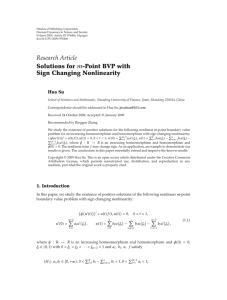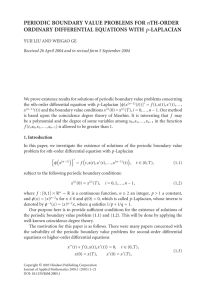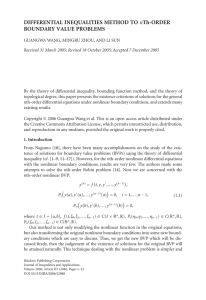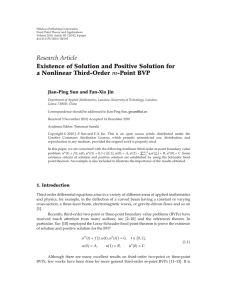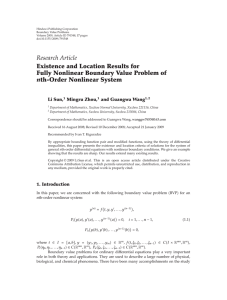Document 10841020
advertisement
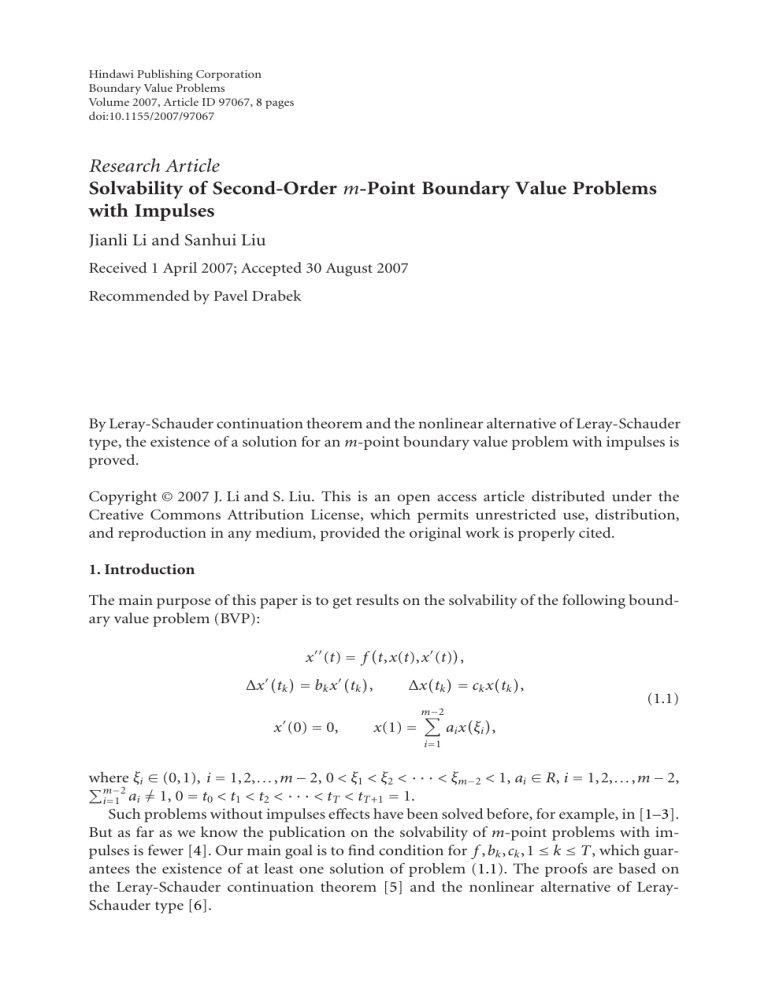
Hindawi Publishing Corporation
Boundary Value Problems
Volume 2007, Article ID 97067, 8 pages
doi:10.1155/2007/97067
Research Article
Solvability of Second-Order m-Point Boundary Value Problems
with Impulses
Jianli Li and Sanhui Liu
Received 1 April 2007; Accepted 30 August 2007
Recommended by Pavel Drabek
By Leray-Schauder continuation theorem and the nonlinear alternative of Leray-Schauder
type, the existence of a solution for an m-point boundary value problem with impulses is
proved.
Copyright © 2007 J. Li and S. Liu. This is an open access article distributed under the
Creative Commons Attribution License, which permits unrestricted use, distribution,
and reproduction in any medium, provided the original work is properly cited.
1. Introduction
The main purpose of this paper is to get results on the solvability of the following boundary value problem (BVP):
x (t) = f t,x(t),x (t) ,
Δx tk = bk x tk ,
x (0) = 0,
Δx tk = ck x tk ,
x(1) =
m
−2
(1.1)
ai x ξ i ,
i =1
where
ξ ∈ (0,1), i = 1,2,...,m − 2, 0 < ξ1 < ξ2 < · · · < ξm−2 < 1, ai ∈ R, i = 1,2,...,m − 2,
m−2 i
i=1 ai = 1, 0 = t0 < t1 < t2 < · · · < tT < tT+1 = 1.
Such problems without impulses effects have been solved before, for example, in [1–3].
But as far as we know the publication on the solvability of m-point problems with impulses is fewer [4]. Our main goal is to find condition for f ,bk ,ck ,1 ≤ k ≤ T, which guarantees the existence of at least one solution of problem (1.1). The proofs are based on
the Leray-Schauder continuation theorem [5] and the nonlinear alternative of LeraySchauder type [6].
2
Boundary Value Problems
In order to define the concept of solution for BVP (1.1), we introduce the following
spaces of functions:
(i) PC[0,1] = {u : [0,1] → R, u is continuous at t = tk , u(tk+ ), u(tk− ) exist, and u(tk− ) =
u(tk )};
(ii) PC 1 [0,1] = {u ∈ PC[0,1] : u is continuously differentiable at t = tk , u (0+ ),
u (tk+ ), u (tk− ) exist and u (tk− ) = u (tk )};
(iii) PC 2 [0,1] = {u ∈ PC 1 [0,1] : u is twice continuously differentiable at t = tk }.
Note that PC[0,1] and PC 1 [0,1] are Banach spaces with the norms
u∞ = sup u(t) : t ∈ [0,1] ,
u1 = max u∞ , u ∞ ,
(1.2)
respectively.
Definition 1.1. The set Ᏺ is said to be quasiequicontinuous in [0,c] if for any ε > 0 there
exists δ > 0 such that if x ∈ Ᏺ, k ∈ Z, t ∗ ,t ∗∗ ∈ (tk−1 ,tk ] ∩ [0,c], and |t ∗ − t ∗∗ | < δ, then
|x(t ∗ ) − x(t ∗∗ )| < ε.
Lemma 1.2 (compactness criterion [7]). The set Ᏺ ⊂ PC([0,c],Rn ) is relatively compact if
and only if one has the following:
(1) Ᏺ is bounded;
(2) Ᏺ is quasiequicontinuous in [0,c].
Lemma 1.3 [7]. Let s ∈ [0,T), ck ≥ 0, αk , k = 1,..., p, are constants and let p, q ∈ PC(J,R),
x ∈ PC 1 (J,R). If
x (t) ≤ p(t)x(t) + q(t),
+
x tk ≤ ck x tk + αk ,
t ∈ [s,T), t = tk ,
tk ∈ [s,T),
(1.3)
then for t ∈ [s,T],
t
x(t) ≤ x s+
ck exp
s<tk <t
t
+
+
s
p(u)du
t
ck exp
u<tk <t
s<tk <t
s
u
p(τ)dτ q(u)du
(1.4)
t
ci exp
tk <ti <t
tk
p(τ)dτ αk .
The result also holds if the above inequalities are reversed.
2. Main results
Theorem 2.1. Let f : [0,1] × R2 → R be a continuous function. Assume that there exist
p(t), q(t), and r(t) : [0,1] → [0, ∞) such that
f (t,u,v) ≤ p(t)|u| + q(t)|v | + r(t)
(2.1)
J. Li and S. Liu 3
for t ∈ [0,1] and all (u,v) ∈ R2 . Then the BVP (1.1) has at least one solution in PC 1 [0,1]
provided
Q + B < 1,
m−2 i =1 a i
1+ 1 − m−2 ai i =1
where P =
1
0
p(t)dt, Q =
1
0 q(t)dt,
B=
(2.2)
P
+ C < 1,
1−Q−B
T
k=1 |bk |,
(2.3)
T
C=
k=1 |ck |.
Proof. Let Y = X = PC 1 [0,1]. Define a linear operator L : D(L) ⊂ X → Y by setting
2
D(L) = x ∈ PC [0,1], x (0) = 0, x(1) =
m
−2
ai x ξ i
,
(2.4)
i=1
and for x ∈ D(L) : Lx = (x ,Δx (tk ),Δx(tk )). We also define a nonlinear mapping F : X →
Y by setting
(Fx)(t) = f t,x(t),x (t) ,bk x tk ,ck x tk .
(2.5)
From the assumption on f , we see that F is a bounded mapping from X to Y . Next, it
is easy to see that L : D(L) → Y is one-to-one mapping. Moreover, it follows easily using
Lemma 1.2 that L−1 F : X → X is a compact mapping.
We note that x ∈ PC 1 [0,1] is a solution of (1.1) if and only if x is a fixed point of the
equation
x = L−1 Fx.
(2.6)
We apply the Leray-Schauder continuation theorem to obtain the existence of a solution
for x = L−1 Fx.
To do this, it suffices to verify that the set of all possible solutions of the family of
equations:
x (t) = λ f t,x(t),x (t) ,
Δx tk+ = λbk x tk ,
x (0) = 0,
Δx tk = λck x tk ,
x(1) =
m
−2
(2.7)
ai x ξ i .
i=1
Integrate (2.7) from 0 to t to obtain
x (t) = λ
t
0
f s,x(s),x (s) ds + λ
0<tk <t
bk x tk .
(2.8)
4
Boundary Value Problems
By condition (2.1), we have
x (t) ≤
t
0
p(s)x + q(s)x + r(s) ds +
T
|bk |x (2.9)
k =1
≤ (Q + B)x + P x + R1 ,
where R1 =
1
0 r(t)dt.
Thus,
x ≤
1
P x + R 1 .
1−Q−B
(2.10)
Integrate (2.8) from t to 1 to obtain
− x(t)
=λ
+
1
0
m
−2
1
1−
H(t,s) f s,x(s),x (s) ds +
m−2
i=1
ai
i=1
ai
1
0
1
t 0<t <s
k
bk x tk ds +
ck x tk
t<tk <1
H ξi ,s f s,x(s),x (s) ds
1
ξi 0<t <s
k
bk x tk ds +
ck x tk
,
ξi <tk <1
(2.11)
where
⎧
⎨1 − t,
H(t,s) = ⎩
1 − s,
0 ≤ s ≤ t ≤ 1,
0 ≤ t ≤ s ≤ 1.
(2.12)
So
m−2 i =1 a i
(P + C)x + (Q + B)x + R1 .
x ≤ 1 + 1 − m−2 ai i =1
(2.13)
Equations (2.10) and (2.13) imply
m−2 P
1 ai
x ≤ 1 + i=
x
+
R
+
C
1 .
1 − m−2 ai 1−Q−B
i=1
(2.14)
It follows from the assumption (2.3) that there is a constant M1 in dependent of λ ∈
[0,1] such that x ≤ M1 . Furthermore, by (2.10), there is a constant M2 such that x ≤
M2 . It is now immediate that the set of solutions of the family of equations (2.7) is, a
priori, bounded in PC 1 [0,1] by a constant independent of λ ∈ [0,1]. This completes the
proof of the theorem.
Theorem 2.2. Let f : [0,1] × R2 → R. Assume that the following conditions hold:
(H1 ) | f (t,u,v)| ≤ q(t)w(max{|u|, |v|}) on [0,1] × R2 with w > 0 continuous and nondecreasing on [0, ∞), q(t) : [0,1] → [0, ∞) is continuous;
J. Li and S. Liu 5
(H2 ) bk ≥ 0, and
C 1+ m−2 i=1 ai
m−2 1 − i =1 a i < 1,
−1
m−2 m−2 r
i=1 ai
i=1 ai
1
−
C
1
+
Q,
> M3 = 1 + sup
1 − m−2 ai 1 − m−2 ai r ≥0 w(r)
i =1
i =1
(2.15)
1
where Q = 0 0<tk <1 (1 + bk )q(s)ds.
Then (1.1) has at least one solution.
> 0 such that
Choose M
M
> M3 .
w M
(2.16)
To show that (1.1)) has at least one solution, we consider the operator
x = λL−1 Fx,
λ ∈ [0,1],
(2.17)
which is equivalent to (2.7). Let x ∈ PC 1 [0,1] be any solution of (2.7), from (H1 ), we have
− q(t)w x1 ≤ x (t) ≤ q(t)w x1 .
(2.18)
Consider the inequalities
x (t) ≤ q(t)w x1 ,
x tk = 1 + bk x tk ,
x (0) = 0,
(2.19)
x (t) ≥ −q(t)w x1 ,
x tk = 1 + bk x tk ,
x (0) = 0.
By Lemma 1.3, we have
x (t) ≤ w x1
t
0 0<t <t
k
1 + bk q(s)ds
≤ Qw x1 ,
x (t) ≥ −w x1
t
0 0<t <t
k
(2.20)
1 + bk q(s)ds
≥ −Qw x1 .
From (2.20), we can deduce
x (t) ≤ Qw x1 ,
(2.21)
6
Boundary Value Problems
and so
x ≤ Qw x1 .
1 t x (s)ds − t<tk <1 ck x(tk )
Using x(t) = x(1) −
x(t) = −
m
−2
1
1−
m−2
i =1
ai
i=1
⎡
ai ⎣
1
ξi
x (s)ds +
(2.22)
and x(1) =
m−2
⎤
ck x tk ⎦ −
ξi <tk <1
i =1
1
t
ai x(ξi ), we have
x (s)ds −
ck x tk ,
t<tk <1
(2.23)
which implies
m−2 i =1 a i
x + C x ,
|x(t)| ≤ 1 + 1 − m−2 ai i =1
(2.24)
and so
−1
m−2 m−2 i =1 a i
i=1 ai
x ≤ 1 + 1−C 1+ x 1 − m−2 ai 1 − m−2 ai i=1
i =1
−1
m−2 m−2 i =1 a i
i=1 ai
≤ 1+ 1−C 1+ Qw x1 .
1 − m−2 ai 1 − m−2 ai i=1
i =1
(2.25)
Set
Now, (2.22) together with (2.25) imply x1 = M.
,
U = u ∈ PC 1 [0,1] : u1 < M
K = E = PC 1 [0,1],
(2.26)
then the nonlinear alternative of Leray-Schauder type [6] guarantees that L−1 F has a fixed
point, that is, (1.1) has a solution x ∈ PC 1 [0,1], which completes the proof.
3. Examples
Example 3.1. Consider the boundary value problem
1
t ∈ [0,1], t = ,
2
1 1 1
Δx tk = x tk , Δx tk = x tk , tk = ,
6
4
2
1 1
1 2
,
− x
x (0) = 0, x(1) = x
2 3
3 3
(3.1)
1
f (t,u,v) = t 5 u + t 3 v + t 2 1 + cos u200 + v30 .
2
(3.2)
f (t,u,v) ≤ p(t)|u| + q(t)|v | + r(t)
(3.3)
x = f t,x,x ,
where
It is easy to see that
J. Li and S. Liu 7
with p(t) = t 5 , q(t) = (1/2)t 3 , r(t) = 2t 2 . Clearly, P = 1/6, Q = 1/8, B = 1/6, C = 1/4, and
Q+B =
7
< 1,
24
1+ m−2 P
33
i=1 ai
+
C
< 1.
=
m−2 1−Q−B
34
1 − i =1 a i (3.4)
By Theorem 2.1, (3.1) has at least one solution.
Example 3.2. Consider the boundary value problem
1
t ∈ [0,1], t = ,
2
1 1
Δx tk = x tk , Δx tk = x tk , tk = ,
3
2
1 1
1 2
,
− x
x (0) = 0, x(1) = x
2 3
2 3
x = f t,x,x ,
(3.5)
where
f (t,u,v) = e−t uα + vβ + μe−t
(3.6)
with α ∈ [0,1], β ∈ [0,1], μ > 0. It is easy to see that
f (t,u,v) ≤ q(t)w max |u|, |v |
(3.7)
with q(t) = e−t , w(s) = sα + sβ + μ. Clearly
m−2 i=1 ai
C 1+ 1 − m−2 ai i=1
=
2
< 1,
3
(3.8)
r
r
= sup α
sup
β + μ = ∞,
w(r)
r
+
r
r ≥0
r ≥0
so (H2 ) is true. Theorem 2.2 shows that (3.5) has at least one solution.
Acknowledgments
This work is supported by the NNSF of China (no. 10571050 and no. 60671066), a project
supported by Scientific Research Fund of Hunan Provicial Equation Department and
Program for Young Excellent Talents in Hunan Normal University.
References
[1] C. P. Gupta, “Solvability of a three-point nonlinear boundary value problem for a second order
ordinary differential equation,” Journal of Mathematical Analysis and Applications, vol. 168, no. 2,
pp. 540–551, 1992.
[2] C. P. Gupta, S. K. Ntouyas, and P. Ch. Tsamatos, “Solvability of an m-point boundary value
problem for second order ordinary differential equations,” Journal of Mathematical Analysis and
Applications, vol. 189, no. 2, pp. 575–584, 1995.
[3] R. Ma, “Existence of positive solutions for superlinear semipositone m-point boundary-value
problems,” Proceedings of the Edinburgh Mathematical Society. Series II, vol. 46, no. 2, pp. 279–
292, 2003.
8
Boundary Value Problems
[4] R. P. Agarwal and D. O’Regan, “A multiplicity result for second order impulsive differential
equations via the Leggett Williams fixed point theorem,” Applied Mathematics and Computation,
vol. 161, no. 2, pp. 433–439, 2005.
[5] J. Mawhin, Topological Degree Methods in Nonlinear Boundary Value Problems, vol. 40 of CBMS
Regional Conference Series in Mathematics, American Mathematical Society, Providence, RI,
USA, 1979.
[6] R. P. Agarwal, D. O’Regan, and P. J. Y. Wong, Positive Solutions of Differential, Difference and
Integral Equations, Kluwer Academic, Dordrecht, The Netherlands, 1999.
[7] D. D. Baı̆nov and P. S. Simeonov, Impulsive Differential Equations: Periodic Solutions and Applications, vol. 66 of Pitman Monographs and Surveys in Pure and Applied Mathematics, Longman
Scientific & Technical, Harlow, UK, 1993.
Jianli Li: Department of Mathematics, Hunan Normal University, Changsha 410081, Hunan, China
Email address: ljianli@sina.com
Sanhui Liu: Department of Mathematics, Hunan Normal University, Changsha 410081, Hunan,
China; Department of Mathematics, Zhuzhou Professional Technology College, Zhuzhou 412000,
Hunan, China
Email address: 000007295@sina.com





